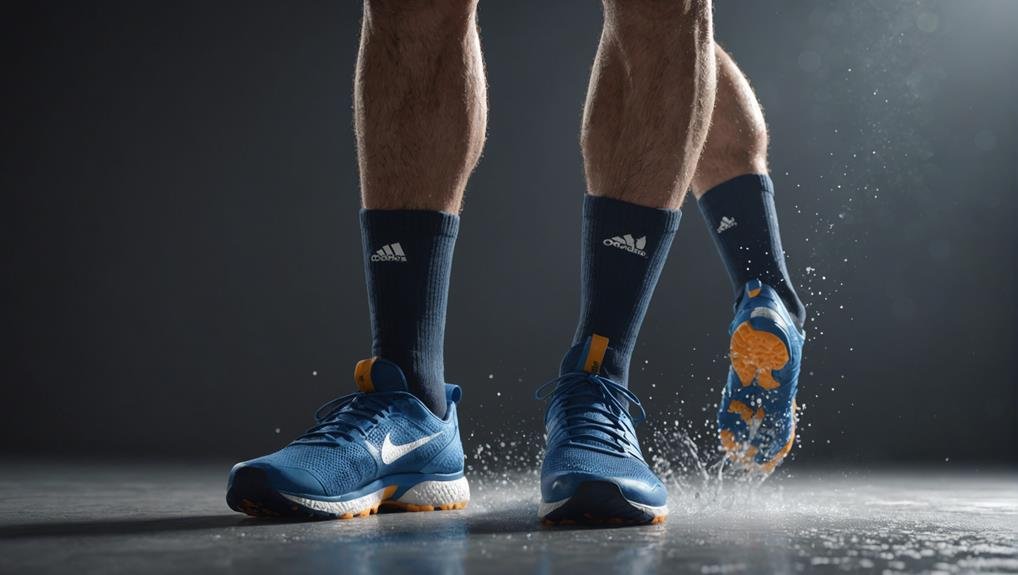Combat Athlete's Foot With These Strategies
Combat Athlete's Foot efficiently by following prevention strategies, treatment options, seeking medical advice, and maintaining foot hygiene. Wash feet daily with soap, especially between toes. Change socks regularly and wear moisture-wicking socks. Use antifungal products like powders or sprays in your shoes. If self-treatment fails, consult a medical professional for tailored treatment plans. Opt for breathable footwear and stay hydrated to prevent dehydration. Consistency in foot hygiene is key to fighting off this irritating infection. Master these strategies to keep Athlete's Foot at bay and maintain healthy feet.
Key Takeaways
- Wash feet daily with soap and water to prevent fungal growth.
- Change socks regularly, especially after sweating, to maintain dryness.
- Use antifungal powder or spray in shoes to deter fungal infections.
- Opt for moisture-wicking socks and breathable shoes to reduce moisture.
- Seek medical advice if self-treatment fails after two weeks for tailored treatment.
Understanding Athlete's Foot
Understanding Athlete's Foot involves recognizing the fungal infection that commonly affects the feet of athletes and individuals in high-risk environments. This fungal infection, known as Athlete's Foot, thrives in warm, damp conditions and is highly contagious.
Proper foot care is crucial to prevent and manage this condition effectively. To take care of your feet, make sure they're kept clean and dry, especially between the toes where moisture can accumulate. Practice good hygiene by washing your feet daily, changing socks regularly, and allowing your feet to breathe by wearing open-toed shoes in communal areas like locker rooms.
Prevention Strategies
To effectively combat Athlete's Foot, implement proactive prevention strategies that focus on maintaining clean and dry feet in high-risk environments. Remember, prevention is key in avoiding fungal infections such as Athlete's Foot. Here are some essential foot care tips to help keep your feet healthy and fungus-free:
- Wash your feet daily with soap and water.
- Make sure your feet are thoroughly dried, especially between the toes.
- Change your socks regularly, especially after sweating.
- Wear moisture-wicking socks and breathable shoes.
- Use antifungal powder or spray in your shoes to prevent fungal growth.
Treatment Options
For effective treatment of Athlete's Foot, prioritize maintaining proper foot hygiene and utilizing recommended antifungal products. Antifungal remedies like creams, sprays, or powders are key in combating the fungal infection.
Make sure you wash and thoroughly dry your feet, especially between the toes, to create an environment where the fungus can't thrive. Incorporate foot care essentials such as wearing clean, breathable socks and well-ventilated shoes.
Look for over-the-counter remedies containing specific antifungal ingredients like clotrimazole or terbinafine. Consistency in treatment is vital for successful recovery.
Seeking Medical Advice
If you've tried self-treatment for Athlete's Foot without improvement after two weeks, consulting a medical professional is the next step to guarantee effective management of the infection. Seeking medical advice is important in dealing with fungal infections.
Here are some reasons why you should consider a healthcare professional specializing in foot care:
- Medical consultation ensures accurate diagnosis and tailored treatment plans.
- Healthcare professionals can prescribe stronger antifungal medications.
- They can offer advice on preventing future infections.
- Foot care specialists can address any underlying conditions that may be exacerbating the infection.
- Consulting a professional ensures proper monitoring of the infection's progress and response to treatment.
Maintaining Foot Hygiene
Maintain excellent foot hygiene to prevent and manage Athlete's Foot effectively.
When it comes to shoe selection, opt for breathable footwear to reduce moisture and inhibit fungal growth.
Choose moisture-wicking socks to keep your feet dry and change them frequently, especially after workouts.
Hydration plays a vital role in foot health, so make sure you drink enough water to prevent dehydration, which can lead to dry, cracked skin that's more prone to infection.
Additionally, after activities that make your feet sweat, make sure to wash and thoroughly dry your feet, paying particular attention to the spaces between your toes.
Conclusion
Now that you have the knowledge and tools to combat athlete's foot, you can confidently step forward on your journey to healthier feet.
Just like a skilled athlete on the field, you can outmaneuver this pesky fungal infection with the right strategies in your playbook.
By taking proactive steps to prevent its spread and treating it effectively, you'll be on your way to kicking athlete's foot to the curb for good.
Keep up the good fight, and soon you'll be back on your feet, itch-free and comfortable.







